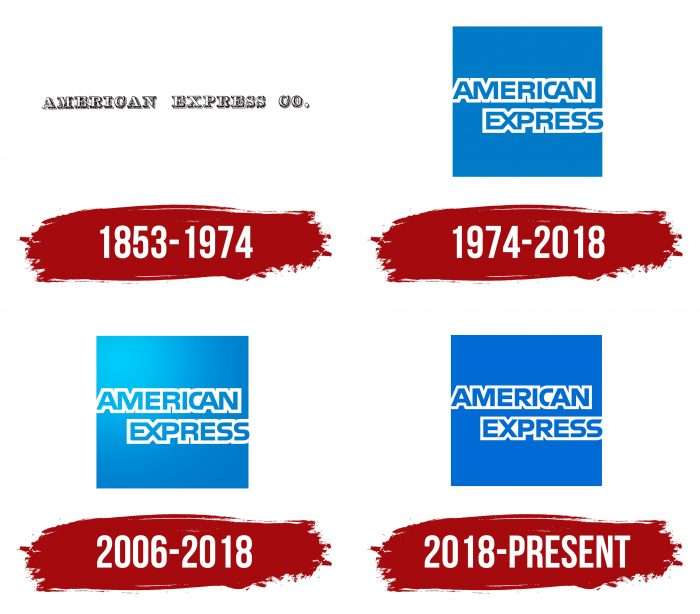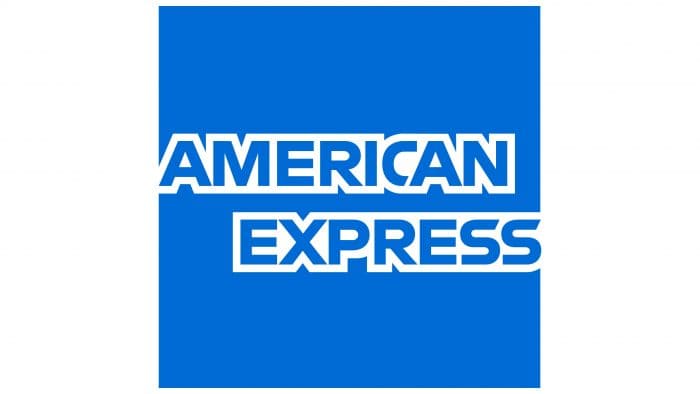For both deposits and transactions, the bank that represents the American Express logo is very reliable. The emblem shows a professional business approach to maintaining customer accounts and compliance with tax laws.
American Express: Brand overview
| Founded: | March 18, 1850 |
| Headquarters: | New York City, NY, United States |
| Website: | americanexpress.com |
Meaning and History
AmEx Corporation has an incredible legacy. When she was in the delivery business, her logo featured a guard dog. In 1915, American Express began selling tickets for ships and trains, so the globe became part of its identity. Then the company turned to money transfers and made a portrait of a Roman gladiator as the main design element. But at the same time, its main emblems were text.
What is American Express?
American Express is one of the twenty largest banks in the United States.
1853 – 1974
For a long time, the inscription “AMERICAN EXPRESS CO.” Was used as a logo, executed in an old serif font. The letters were white in the middle and black at the edges.
1974 – 2018
In 1974 the most famous symbol of the company appeared – the so-called Blue Box. Its first version looked like a two-line “AMERICAN EXPRESS” lettering inside a blue square. The letters were separated from each other by wide white lines, but they merged in some places.
2006 – 2018
In the new millennium, designers have changed the palette and added a gradient with a smooth transition from white to blue. The center of the light spot was in the upper left corner of the square.
2018 – today
In 2018, branding agency Pentagram revamped the AmEx logo to suit digital media. The designers erased the gradient and made the image flat, thus reducing the number of pixels. This made the letters more legible.
American Express: Interesting Facts
American Express, or Amex, is a major financial services company based in New York City. Founded in 1850, it’s become a top and well-known brand.
- Early Days: It started in Buffalo, New York, as an express mail business by Henry Wells, William G. Fargo, and John Warren Butterfield, combining their freight forwarding companies.
- Traveler’s Cheques: In 1891, Amex introduced them, making it safer and easier for travelers to carry money internationally.
- Charge Cards: The company entered the consumer finance market in 1958 with its first charge card, changing how people pay and manage money.
- Rewards Program: The Membership Rewards program, started in 1991, was one of the credit card industry’s first loyalty programs, offering points for purchases that could be exchanged for various rewards.
- Business Services: Amex also leads in providing business services, like financing, corporate cards, and payment processing, meeting the needs of all business sizes.
- Global Reach: Amex cards are accepted in over 130 countries and show the brand’s worldwide presence. They’ve expanded their merchant network globally for card member convenience.
- Exclusive Offers: Known for unique partnerships and benefits, Amex offers cardholders special perks like presale concert tickets and luxury travel experiences.
- Small Business Support: Amex created Small Business Saturday in 2010 to encourage shopping at small businesses on Saturdays after Thanksgiving, promoting support for small businesses in the U.S.
- Centurion Card: The exclusive “Black Card,” available by invitation only, provides luxury benefits like concierge service and premium travel perks.
American Express’s innovations and services have firmly placed it as a leader in the financial services field. The company focuses strongly on customer service, business solutions, and corporate responsibility.
Font and Colors
The Blue Box symbol unites several areas of American Express business. It has been in use since 1974, but only the latest version is considered the most expressive and looks good at any scale.
The entire square area is bright blue, except for the white lines that outline the company name. Outline letters were created in 1974, especially for the AmEx logo. In 2018, typographer Jeremy Mickel redesigned the lettering by changing and separating some of the signs.
FAQ
What font is the American Express?
The brand uses two main fonts: Benton Sans and Guardian.
Benton Sans is a clean and modern sans-serif font. It is used in the brand’s marketing materials, digital platforms, and other communications to ensure clarity and professionalism. Its simplicity and readability help maintain a sleek and contemporary appearance.
Guardian is a serif font that adds a touch of elegance and tradition. It is used in printed materials and formal communications. The combination of Guardian’s classic style with the modern look of Benton Sans creates a balanced and versatile typography for the brand.
Why did American Express change its logo?
American Express changed its logo to refresh the iconic Blue Box, first introduced in 1975. The goal was to create a bolder, more confident look for the brand and develop a typographic style that could work outside the Blue Box.
The project aimed to modernize the logo while keeping its recognizable elements. The updated design shows the brand’s evolution and commitment to staying relevant in a competitive market. Making the logo more versatile ensures it can adapt to various media and platforms.
The new logo helps the company communicate its values more clearly, ensuring it remains a strong and recognizable symbol in the financial industry.
What is the logo for American Express?
The current American Express logo features the brand name inside a blue square. This simple, clean design highlights the recognizable name, ensuring clarity and a modern look.
The emblem created in 1958 depicts a centurion or gladiator. This image represents strength, trust, and protection, symbolizing the brand’s commitment to security and service.
While the main logo has become more streamlined, the centurion remains important to the brand’s heritage. It is still used in some marketing and branding materials. This blend of the modern logo and historical emblem helps the company maintain its rich history while projecting a contemporary image.
Who owns American Express?
The company has many owners, mainly institutional investors. Berkshire Hathaway, Inc., The Vanguard Group, Inc., State Street Corporation, and Dodge & Cox are the largest shareholders.
Berkshire Hathaway, led by Warren Buffett, holds the most significant share. This shows Buffett’s long-term confidence in the brand’s stability and growth potential. The Vanguard Group and State Street Corporation are major asset management firms that manage large portfolios, including shares of the brand. Dodge & Cox, another respected investment firm, holds a substantial stake.
These institutional investors own a large portion of the brand, showing strong confidence in its future. Their involvement provides financial stability and support for continued growth in the financial industry.
What does American Express do?
American Express provides various financial services, including issuing credit and charge cards, offering personal and business loans, and handling financial transactions. The brand is well-known for its credit cards, which offer rewards, benefits, and perks tailored to different customer needs.
The brand offers financial advice and wealth management services, helping clients with investment strategies, retirement planning, and other financial goals. It provides travel-related services, such as travel booking, insurance, and assistance, integrated with premium card offerings.
The company serves both individuals and businesses. The brand offers corporate cards, expense management tools, and business financing options for businesses. These services help businesses manage finances efficiently and benefit from valuable rewards and perks.
What is the Amex slogan?
The company slogan is “Don’t Leave Home Without It.” This iconic phrase has been a key part of the brand’s marketing for many years. It emphasizes the importance and reliability of having an American Express card wherever you go.
The slogan suggests that the card is essential for handling various financial needs, whether traveling or during daily activities. It shows the card’s security, convenience, and benefits, making it indispensable. “Don’t Leave Home Without It” is one of the most memorable and recognizable slogans in advertising history.









